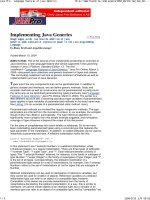Tài liệu The Evolution of Internet Telephony pptx
Bạn đang xem bản rút gọn của tài liệu. Xem và tải ngay bản đầy đủ của tài liệu tại đây (268.6 KB, 25 trang )
White Paper:
The Future of Online Communication
Section I: The Evolution of Internet Telephony
H. Mine, Executive Vice President, Probe Research, Inc.
Section II: AT&T’s IP Telephony Initiatives
October 1998
Section I: The Evolution of Internet Telephony
Hilary Mine
Probe Research, Inc.
Three Wing Drive, Suite 240
Cedar Knolls, NJ 07927
www.proberesearch.com
Tel: 973-285-1500
September 1998
TABLE OF CONTENTS
VOICE AND DATA – CONVERGENCE HAS BEEN A LONG TIME COMING ...........................................4
EMERGENCE OF THE INTERNET ............................................................................................................................6
INTERNET TELEPHONY - MARKET EVOLUTION AND DRIVERS .............................................................8
HOBBYIST PHASE - IP TELEPHONY AS HAM RADIO SUBSTITUTE....................................................................................9
TARIFF ARBITRAGE - CALLING CARD REPLACEMENT.....................................................................................................9
TARIFF ARBITRAGE - ENTERPRISE TRUNK REPLACEMENT............................................................................................11
FEATURE PARITY..............................................................................................................................................................11
NEW APPLICATIONS.........................................................................................................................................................12
Conferencing Applications.................................................................................................................................12
Call Center Applications....................................................................................................................................13
IP Messaging......................................................................................................................................................14
IP Call Waiting...................................................................................................................................................14
COST PARITY....................................................................................................................................................................14
MARKET AND TECHNOLOGY BARRIERS TO INTERNET TELEPHONY AND THE NEW PUBLIC
NETWORK........................................................................................................................................................................15
INTEROPERABILITY CHALLENGES....................................................................................................................................15
QUALITY OF SERVICE.......................................................................................................................................................16
COST TO DEPLOY IPT......................................................................................................................................................17
OPERATIONAL SUPPORT SYSTEMS..................................................................................................................................17
REGULATION - THE VERY REAL THREAT........................................................................................................17
SERVICE MARKET OPPORTUNITIES IN INTERNET TELEPHONY..........................................................18
THE VALUE OF EARLY MARKET LEADERSHIP/ TODAY’S INTERNET TELEPHONY SERVICE
PROVIDERS.....................................................................................................................................................................20
AT&T IP TELEPHONY INITIATIVES .....................................................................................................................23
CONSUMERS.....................................................................................................................................................................23
CARRIERS.........................................................................................................................................................................23
BUSINESS CUSTOMERS....................................................................................................................................................24
RESEARCH INITIATIVES...................................................................................................................................................24
AT&T ADVANTAGE.........................................................................................................................................................24
SUMMARY........................................................................................................................................................................25
Voice and Data – Convergence Has Been A Long Time Coming
The promise of a single network carrying both voice and data is as old the first data networks
themselves. The fundamental notion that a single network offers economic advantages, both in
terms of upfront equipment costs, and with respect to management and administration costs, goes
back literally decades. Perhaps the most famous failure of convergence was ISDN (Integrated
Services Digital Network, or “It Still Does Nothing” as it is colloquially referred to), which is
finally beginning to be deployed today, but which has been available to service providers since
the mid 1980s.
Just as its name implies, the idea behind ISDN was integration of voice and data over the public
network. The expectation was that a customer would use one 64 Kbps B channel for voice, and
the other for data. But carriers did not deploy the technology in any significant way in the U.S.,
largely because their business structures prevented them from being able to prove in business
cases. In addition, as is generally true of new technologies, the developments of true
interoperability and standards, as well as the cost of early customer premise equipment (e.g.,
modems) were also significant barriers to the success of ISDN.
Finally, however, there was a lack of mass market demand for data networking. This particular
market barrier remains, of course, subject to much debate. Despite the fact that 45% of US
homes have at least one PC in use, and the majority of those are Internet subscribers, there are
still those in traditional carriers (e.g. BellSouth) who remain convinced that end users are not
willing to pay the true costs to provide data network services, with the exception of a few large
business customers.
With the advent of the Internet, there is little doubt that end users in both the consumer and
business markets are very interested in data services. Willingness to pay has still to be proven in,
since the mass market Internet is arguably being subsidized at this time. Nonetheless, data traffic
even prior to the rise of the Internet, has been growing dramatically faster than voice traffic, and
this pattern is at the crux of the integrated network dream.
Terabytes/Yr
1997 1998 1999 2000 2001 2002 2003 2004 2005
Figure 1: GLOBAL NETWORK TRAFFIC
PSTN VOICE PACKET & PRIVATE WAN VOICE
PSTN DATA PACKET & PRIVATE WAN DATA
Source: Probe Research, Inc. estimates
Figure 1 shows Probe's estimates of total global communications traffic. PSTN refers to the
public switched telephone network, or the traditional telephone network. Private Wide Area
Networks (WANs) refer to leased line and virtual private networks (VPNs) that large companies
and institutions use for internal communications. Packet refers to packet network based traffic.
Today, over 70-75% of this traffic is still voice, but as we have observed, data is growing much
faster. By the year 2005, data will account for nearly half of global traffic. It is critically
important to note, however, that voice traffic will be growing as well over this period, and will
still be the bulk of traffic on many routes.
A few service providers have begun to observe portions of their networks reaching the magic 50%
data traffic threshold, and anticipate that on some segments (particularly international routes),
data traffic will account for as much as 80% of traffic within the next 5-7 years. This is generally
true of routes (e.g., Tokyo to London) that are dominated by business traffic. As a rule, the more
local the traffic, the more it is dominated by residential and small business traffic, and
consequently, the more it is dominated by voice versus data traffic.
In the long run, multimedia applications that are targeted to consumers, such as interactive video,
Internet TV, videoconferencing, and more, will radically alter the mix of voice and data. Once
the standards, customer premise equipment, applications, and above all the economics come
together, then voice traffic will indeed be eclipsed. Based on Probe's ongoing analysis of
bandwidth to the home and small office, and all of the associated terminal equipment, standards,
and other issues surrounding the take off of residential multimedia, we remain convinced that
mass market adoption is at least five years off even in the best of circumstances (e.g., in the heart
of Silicon Valley). This is not to say that there are not already many households that generate
more data than voice traffic (e.g., in Silicon Valley), but rather that it will be some time before
early adopters give way to mass market consumers. For most communities, mass market
adoption is even further away (7 years or more).
Emergence of the Internet
The overwhelming driver of data traffic today is the Internet, as well as wide area private/virtual
private IP networks (e.g., Intranets and Extranets). While global voice traffic continues to grow at
less then 8% annually, data traffic is growing at roughly 35%. Although the Internet Protocol has
been defined for decades, its use became widespread only recently.
The market for Internet services was born in great part due to the privatization and
commercialization of NSFnet. Indeed several key players, including BBN Planet, MCI, Sprint,
etc., originally became involved in the Internet as government contractors. Others, including
UUNet and PSINet, launched commercial services in 1991, as soon as the NSF allowed it, and
were founded and staffed by NSFNet veterans. While proprietary online services and Bulletin
Board Systems (BBS') attracted aficionados and hobbyists for over a decade, the audience for
these services remained limited due to constraints on content, incompatibility between networks,
and exceedingly slow access, as well as the basic issue of limited PC deployment. In the early
1990s, however, several factors coincided to cause the Internet to become a viable commercial
platform:
1991 - NSF allowed commercial use of the Internet, and the first Commercial Internet
Exchange was launched;
1992 - The number of Internet hosts reached 1 million (largely academic and military);
1993 - WWW and the Mosaic browser were introduced; and
1994 - The penetration rate of PCs in US homes reached 33%; 28.8 Kbps modem standard
was approved.
By year end 1998, PC penetration amongst US households is approaching 45%. Importantly, this
figure takes into account households with multiple PCs, and excludes those with inactive PCs.
-
500
1,000
1,500
2,000
2,500
3,000
1991 1992 1993 1994 1995 1996 1997
FIGURE 2: INTERNET TRAFFIC: 1991-1997
(Terabytes/Month)
Sourc e: NSFNet ac tuals to 12 /94; Pr obe estimates after 12/94
NSF Allows
Commercial
Internet Use
Global
Internet
Users pass
50M
Internet
Users
Pass
10M
PC Penetration
in US Homes
reaches 33%;
28.8Kbps
Modem
Standard
Approved
WWW and
Mosaic
Introduced
OSP
business
model
fails; OSPs
become
ISPs
By year end 1998, there will be an estimated 100 million Internet users worldwide (including
business, consumer, students, etc.). See Figure 3. For perspective, there are well over 600 million
telephone users worldwide. Nonetheless, the Internet has proven to be the clear technology
winner as a user interface to a global public data network.
1997 1998 1999 2000 2001 2002
-
50,000,000
100,000,000
150,000,000
200,000,000
250,000,000
300,000,000
Internet Users
1997 1998 1999 2000 2001 2002
Figure 3: Worldwide Internet Users: 1997-2002
Europe/Middle East/Africa Asia/Pacific
North America Latin America/Caribbean
Source: Probe Research, Inc. estimates
Internet Telephony - Market Evolution and Drivers
In its brief life, IPT has already seen two distinct phases of market evolution, and is on the verge
of a third. In this section we describe the expected development of IPT as a market, and explore
the factors that will drive each phase of adoption of the technology. Figure 4 provides a general
overview of the evolution, including Probe's projections of global voice and fax over IP in
minutes of use.
0.0000
10000.0000
20000.0000
30000.0000
40000.0000
50000.0000
60000.0000
70000.0000
80000.0000
90000.0000
Millions of Minutes
1996 1997 1998 1999 2000 2001 2002 2003 2004 2005
Figure 4: GLOBAL VOICE/FAX OVER IP TRAFFIC
AND MARKET DRIVERS
Source: Probe Research, Inc.
Tariff
Arbitrage
Feature
Parity
New Applications
Cost Parity
Hobbyist
Hobbyist Phase - IP Telephony as Ham Radio Substitute
In late 1995, a few technologists and hobbyists recognized the potential of the Internet to carry
voice traffic. Companies such as VocalTec, NetSpeak, Quarterdeck, and others developed a new
class of software that enabled any two Internet users to talk to each other from their PCs. This
approach, which relied entirely on the PCs at each end, required not only soundcards and high
speed modems at each end, but also that end users use the same software. Each solution was
proprietary – a VocalTec user could not talk to a NetSpeak user. Nonetheless, the draw of free
phone calls was compelling. By year end 1996, over a million copies of this class of software had
shipped, and players like Microsoft and Intel had jumped in to develop standards-based client
software as part of their larger vision of using the Internet as an alternative voice and
conferencing platform.
Not surprisingly, early adopters of this technology largely treated it as a chat room alternative.
VocalTec and other companies set up Internet relay chat rooms (IRCs), where users could go to
find other users with the same software, or where users might set up private meetings. Despite all
the awkwardness of this form of communication, literally millions of conversations were
completed between PC users over the Internet in 1996.
Tariff Arbitrage - Calling Card Replacement
The long distance communications market is extremely price elastic. This is important because it
is currently the underlying market driver for Internet telephony, and will remain so for the next
three to five years. To support this statement, consider the impact of competition on the US long
distance market in the 1980s. Figure 5 shows indices of price per minute versus minutes of use of
interstate long distance in the US during the period 1981 to 1993. As prices fell, traffic grew
considerably. Indeed the highest rates of traffic growth occurred during the period 1984 through
1988, when prices were falling their fastest (an average of 7.3% annually).
Figure 5: Price Sensitivity in Long Distance
0.0%
2.0%
4.0%
6.0%
8.0%
10.0%
12.0%
14.0%
16.0%
18.0%
1985 1986 1987 1988 1989 1990 1991 1992 1993 1994
Annual Percetnage Increase in Minutes of
Conversation
-12.0%
-10.0%
-8.0%
-6.0%
-4.0%
-2.0%
0.0%
2.0%
Annual Percentage Change in Price per Minute
Source: FCC and Probe Research, Inc. estimates
Price
Traffic
Early adopters of IP telephony quickly realized that the initial acceptance of the technology
hinged on its ability to bypass regulatory regimes and tariff structures. International call back
service providers, such as IDT, were among those most threatened. Their customers are amongst
the most price sensitive, and are willing to dial additional digits or suffer other inconveniences to
save money. Consequently, these types of service providers were the first to develop IP telephony
services. Other service providers, such as AT&T, Sprint, etc. also paid early attention to IPT as a
threat and therefore also an opportunity.
Simultaneously, vendors such as VocalTec, Vienna Systems, and Clarent Corp. recognized that
while the PC hobbyist market was a nice start, the installed base of multimedia computers was
rather limited compared to the installed base of traditional telephones. Moreover, the biggest
problem with IPT, the quality of the voice, was seriously affected by the end user’s own ability to
configure their system (the PC, the software settings, etc), and the reality is that non-hobbyist
users are more interested in communicating than in understanding the finer points of codecs. The
market potential of phone-to-phone and PC-to-phone IPT drove the development of first









